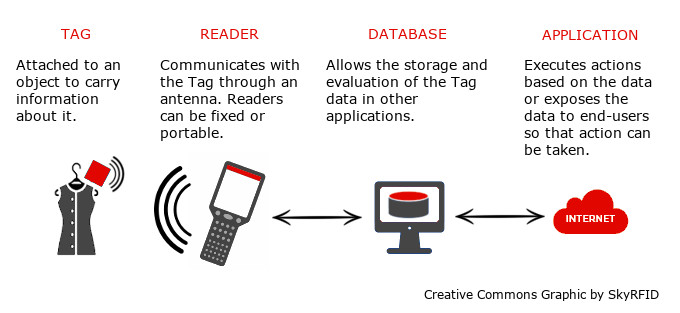
RFID stands for Radio Frequency IDentification.
The new RAIN RFID standard is also an acronym (RAdio frequency IdentificatioN) designed to help consumers better link the possibilities and capabilities of RFID with Cloud Computing based applications, which is usually where the data resides.
At the highest level, how RFID works is by powering an RFID Tag, usually by the RFID readers signal once it comes into close enough proximity, so that the tag is able to send it's unique identification number to the reader. This unique identification number can then be cross checked in a sub-system to see what asset or person is being identified.

The more technical answer is that RFID transmits data through electromagnetism. Small, electrically-charged particles interact with each other, creating an electromagnetic field. This field is made up of different waves of photons; the collection of waves from lowest to highest frequency is what we call the electromagnetic spectrum.
Every day, you use several devices that rely on communicating through the generation of waves in the electromagnetic spectrum. For example, radio stations use transmitters to generate waves sending music to the receiver in your car radio. RFID uses this same principal to send information between the tag and the reader.
The two broad uses for RFID are 1- Access Control, and 2- Asset Tracking. Chances are you already use RFID and didn't know it.
This is just a few real world examples, the application of RFID is near limitless.
This is country specific and in some cases further regulated by the region or city. This list is by no means the full list of all of the different frequency regulations. To ensure your compliance with local regulations make sure that you review the current standards prior to purchasing your readers.
Frequency |
Maximum Transmit Power |
| 125 kHz & 134.2 kHz | 72 dBμA/m |
| 13.56 MHz | 60 dBμA/m |
| 433 MHz | 0.1 Watts |
| 860 - 960 MHz | Download the GS1 Regulations Outline |
| 2.4 - 2.483 GHz | 4 W indoor 0.5 W EIRP outdoor |
| 5.725 - 5.875 GHz | 4 W USA/Canada 0.5 W Europe |
We offer a FREE RFID basics course which is broken down into 6 lessons that can be completed in about 30 minutes. You get one lesson per day delivered to your email for a week, which will give you the essential knowledge you need to ensure your new RFID system meets your expectations. Sign up below.